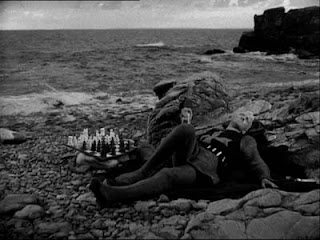http://gcaggiano.files.wordpress.com/2010/07/6a00d8353342be69e200e54f32c7518834-800wi.jpg
Source:
http://www.dvdtimes.co.uk/protectedimage.php.image=NoelMegahey/seventhseal1.jpg_12122007&cachedimage=true&width=400
Analysis of the fist two minutes of the film:
· The opening scene begins with a wide shot of the stormy sky. The sky has a powerful light of the sun coming through an opening in the clouds. The shot is escorted by loud, breath-taking sound of the orchestra. A viewer seeing this picture for the first time may make an association to God after being exposed to such a powerful scene. However such an association may fade as the viewer witnesses the second shot.
· The use of Continuity Editing reoccurs all throughout the opening scenes. (Corrigan and White. P 149)
· In the second shot, the image of the sky is slowly replaced with an image of a black silhouette of a bird (possibly an eagle.) The bird is freely floating through the air. Perhaps such image is intended to suggest an idea of a chase or the presence of death (Possibly the Grim Reaper or even the Black Plague). The bird’s dark wings are a metaphor to Grim Reaper's black cloak.
· The third shot is an Extreme Wide Shot (Media College. Shot types) of the landscape. This shot is especially interesting because it is used to divide the landscape into a ying yang-like shape; where the land becomes the dark and the water becomes the light. Through such imagery, the editor suggests the presence of two reoccurring themes in the film: good and evil, or life and death. A similar pattern is repeated in the next shot, which is taken from a High Angle, (Media Shots. Shot Types) from the top of the mountain, overlooking the beach. The editor takes full advantage of the privileges of black and white cinema, as he experiments with the contrasts in volume and manipulation of artificial and natural light.
· The next two shots are done in a similar manner to each other. Using Wide Shots (Media Shots. Shot Types), two of the main characters are introduced into the scene. In each shot, they both appear to be either dead or sleeping. They are displayed in the light. This time the contrast between the beach and the water is reversed. The water appears to be darker than the beach. The significance of the ocean in this particular part of the scene is to indicate through the rhythmic sound of its waves the possibility of the characters breathing. The repetition of the sound of the waves crashing into the shore is intended to points to out that the knight and the squire must still be live.
· The shot that follows next, introduces the idea of a journey that may lie ahead. The composition within the shot, displays two horses, which represent journey.
· Next, the camera fades into a close up of the knight who is holding on to his sword. This reveals his occupation and the fact that he is in distress.
- Next, follows a Close Up (Mediaknowall) on the knight’s companion, squire. The squire appears to be exhausted and barely moving, however he also hold on his dagger.
- After that follows a montage sequence (Corrigan and White. P. 139) The montage sequence is very important to the introduction of the main theme of the film.
Montage (consists of 4 parts) :
- Starting with a Wide Shot (Media Shots) of the Knight walking toward the light surface of the water to wash off.
- Then, the use of a Very Wide Shot captures him walking in the direction of the viewer, away from the sea. The sea, in this shot is once again displayed as dark colored. Perhaps this is yet another suggestion of the conflict between life and death
- The third shot if the sequence shows the knight on his knees, praying. Which introduces a religious element into the scene.
- And the final part of the sequence, shows the knight walking toward the beach again, however as soon as he gets closer the camera merges to the right and focuses on the chess board, that is rests on the rocks. Te chess pieces are also black and white.
Work Cited
"Camera Angles." Mediaknowall. Web. 25 May 2011. <http://www.mediaknowall.com/camangles.html>.
"Camera Shots." Media College - Video, Audio and Multimedia Resources. Web. 25 May 2011. <http://www.mediacollege.com/video/shots/>.
Corrigan, Timothy, and Patricia White. Film Experience: an Introduction. New York, NY: Bedford/St. Martins, 2009. Print.
"Google Images." Google. Web. 25 May 2011. <http://www.google.com/imgres?imgurl=http://g-ecx.images-amazon.com/images/G/01/dvd/afaddis/image/SeventhSeal4.jpg>.
"Google Images." Google. Web. 25 May 2011. <http://www.google.com/imgres?imgurl=http://www.dvdtimes.co.uk/protectedimage.php?image=NoelMegahey/seventhseal1.jpg_12122007&cachedimage=true&width=400>.
"The Seventh Seal." Wikipedia, the Free Encyclopedia. Web. 25 May 2011. <http://en.wikipedia.org/wiki/The_Seventh_Seal>.
"YouTube - Ingmar Bergman - The Seventh Seal ." YouTube - Broadcast Yourself. Web. 25 May 2011. <http://www.youtube.com/watch?v=HtqB2XO9jtI>.


No comments:
Post a Comment